Hybrid Fitted Numerical Scheme for Singularly Perturbed Convection-Diffusion Problem with a Small Time Lag
Abstract
In this article, a singularly perturbed convection-diffusion problem with a small time lag is examined. Because of the appearance of a small perturbation parameter, a boundary layer is observed in the solution of the problem. A hybrid scheme has been constructed, which is a combination of the cubic spline method in the boundary layer region and the midpoint upwind scheme in the outer layer region on a piecewise Shishkin mesh in the spatial direction. For the discretization of the time derivative, the Crank-Nicolson method is used. Error analysis of the proposed method has been performed. We found that the proposed scheme is second-order convergent. Numerical examples are given, and the numerical results are in agreement with the theoretical results. Comparisons are made, and the results of the proposed scheme give more accurate solutions and a higher rate of convergence as compared to some previous findings available in the literature.
1. Introduction
The delay differential equations are versatile in mathematical modeling of processes where they provide a realistic simulation of the real-world phenomena. The real-world operations/interactions that take time to complete can be utilized to simulate the time lag experience such as gestation time, incubation period, and transportation delays. In the model, if a small parameter multiplies the highest order derivative term, involving at least one shift term in the temporal variable, we call it singularly perturbed time delay differential equations (SPTDDE). These problems arise in the varied area of science and engineering models, for instance, in population dynamics, in epidemiology, in respiratory system, and in tumor growth [1–6]. For more additional models, one can refer [7, 8]. Due to the appearance of the boundary layer in the solution of a singularly perturbed differential equation, classical numerical methods on equidistant grids are inadequate and fail to provide a reliable approximation, when the perturbation parameter tends to zero, unless otherwise, if one uses an unacceptably large number of grid points. Several articles have been written on the solution method for singularly perturbed delay differential equations, to cite a few [9–13]. Among the recently conducted studies on SPTDDE of the convection-diffusion type, having a right end boundary layer, in [14], the authors used an implicit-trapezoidal scheme on uniform mesh for temporal discretization, and for spatial discretization, a hybrid scheme, which is a combination of the midpoint upwind scheme and the central difference scheme on Shishkin type meshes, is applied. In [8], the scheme is constructed using the Crank-Nicolson method for temporal discretization, and a midpoint upwind finite difference scheme on a fitted piecewise-uniform mesh in spatial discretization is applied. In [15], the scheme is devised using backward Euler’s scheme on uniform mesh for temporal discretization and a new stable finite difference scheme on Shishkin mesh for spatial discretization. In [16], the problem is solved using the Crank-Nicolson method in temporal discretization, and in the spatial discretization, an exponentially fitted operator finite difference method on uniform mesh is used. All these developed schemes can work for both small and large time delays. However, except [14], the results of the above studies are first-order convergent, and there are some exceptional properties which work only for a small time delay (δ < ε) that cannot be assessed by these authors.
So, when we come to a singularly perturbed convection-diffusion problem of small time lag, the following researchers address the case which works only for small time lag. In [17], the authors used the backward Euler scheme for temporal discretization and a central difference scheme with an adaptive mesh selection strategy for spatial discretization. In [18], the authors used the Euler method to discretize the time derivative and a B-spline collocation scheme for the spatial discretization on a uniform mesh. In this paper, both small and large time delays are considered, and the developed scheme is first-order convergent. In [19], the scheme is developed using the backward Euler method in the discretization of the time derivative, and a higher-order finite difference method is employed for the approximation of the spatial derivative. In this scheme, an exponential fitting factor is introduced, and the resulting scheme is first-order convergent.
From these, we are motivated to construct and analyze a higher order ε-uniform numerical scheme, for the problem considered in [17]. The proposed hybrid scheme is a combination of the cubic spline method and the midpoint upwind scheme on piecewise Shishkin mesh in the spatial direction and the Crank-Nicolson method in the temporal direction. The advantage of the present method over the other methods in [17–19] is that it is a second-order accurate in both time and space variables, as well as its accuracy. In addition, in the paper [17–19], Taylor’s series expansion is applied at the beginning without any restriction on the domain. In such a case, the advantage of the interval condition for the delay term in the approximation is meaningless. So we incorporate the condition where Taylor’s series expansion is applied without losing the interval condition.
Notations: all through this paper, C and its subscripts denote generic positive constants independent of the perturbation parameter ε and mesh sizes. Also, ‖∙‖ denotes the standard supremum norm, defined as for a function f defined on some domain .
2. Problem Formulation
3. Bounds on the Solution and Its Derivatives
Lemma 1. Suppose . Assume that ξ(0, t) ≥ 0, ξ(1, t) ≥ 0, and Lεξ(x, t) ≥ 0, ∀(x, t) ∈ D. Then, .
Proof. Suppose such that and ξ(x⋆, t⋆) < 0. It is visible that (x⋆, t⋆) ∉ Γ and (x⋆, t⋆) ∈ D. At the point (x⋆, t⋆), ξx = 0, ξt = 0 and ξxx ≥ 0. Then, Lε(x⋆, t⋆) < 0, which contradicts Lε(x, t) ≥ 0, ∀(x, t) ∈ D. Therefore,
Lemma 2. The solution u(x, t) of problem (1) is bounded and satisfies the following estimate:
Proof. Please refer [21].
Lemma 3. The solution to the problem (1) satisfies the following bound:
Proof. Please refer [22].
Lemma 4. The solution u(x, t) of (1) satisfies the bound
Proof. Let us take |u(x, t)| = |u(x, t) − ψb(x, t) + ψb(x, t)| ≤ |u(x, t) − ψb(x, t)| + |ψb(x, t)|. Using Lemma 3, |u(x, t)| ≤ Ct + |ψb(x, t)| and the fact that ψb(x, t) is bounded and t ∈ (0, 2]. Hence, we get the required result.
Lemma 5. Let u be the solution of problem (1), then
4. Numerical Scheme
4.1. Temporal Discretization
Lemma 6. Suppose that . The local truncation error associated to scheme (15) satisfies
Proof. Using Taylor’s series expansion, expanding U(x, tj+1) and U(x, tj) centered at tj+1/2, we get
Substituting (18) in to (1), we obtain
From (19), the local truncation error is the solution of the following BVP:
Theorem 7 (global error estimate). The global error estimate in the time direction at (j + 1)th time level is given by
Proof. Using the local error estimate in Lemma 6, we obtain
Lemma 8 (discrete maximum principle). Suppose . Assume that ξj+1(0) ≥ 0, ξj+1(1) ≥ 0, and . Then, ξj+1(x) ≥ 0, ∀(x) ∈ Ω.
Proof. Suppose such that ; let ξ(x⋆, tj+1) < 0. This gives (x⋆, tj+1) ∉ {(0, tj+1), (1, tj+1)}, which implies that the point (x⋆, tj+1) ∈ Ωx. Also, we have and .
To prove that the approach is ε-uniform, more specific information on the behavior of the exact solution is required. This is done by decomposing the solution u(x, t) into a smooth component vε and a singular component wε as follows: u = vε + wε; for more detail on the decomposition, one can refer [25].
Lemma 9. The regular and the singular components of the solution of the discrete scheme (15) satisfy the following bounds:
4.2. Discretization in the Spatial Direction
4.2.1. Shishkin Mesh
4.3. Cubic Spline Difference Scheme
- (i)
Qj+1(x) coincides with a polynomial of degree three on each subintervals [xi−1, xi], i = 1, ⋯, N
- (ii)
- (iii)
Q(xi) = U(xi), i = 0, 1, ⋯, N
4.4. Midpoint Upwind Scheme
4.4.1. Hybrid Scheme
5. Stability and Error Analysis
In this section, we study the stability and ε-uniform convergence of the proposed scheme. For the analysis, we follow the approach given in [23, 25]. The numerical solution UN,M on D is decomposed as U = V + W, where V and W are the numerical solutions of the regular and singular components, respectively; for detail on the decomposition, please refer [25].
Lemma 10. Assume that N ≥ N0, where N0 is the smallest positive integer satisfying
Then, we have
Proof. Divide the interval into two cases.
Case 1. For 1 ≤ i ≤ N/2, since the mesh is piecewise uniform, so that it is possible to fix the mesh size in the inner layer region by hi = h = 2τ0εlnN/lnN and substitute (47) into (39) and simply, we get
since |α0| < ‖α‖, h < 1/N and (48).
Similarly, s+ < 0, and from (39), it is clear that
Case 2. For N/2 < i < N, the mesh size in the outer layer region is hi = (2(1 − τ0εlogN)/N) < 2/N. Next, using (47) and (48) into (44), it is easy to see that s− < 0 and s+ < 0. Simple mathematical calculation gives
Hence, the proof is completed.
Note: Lemma 10 confirms that under the hypotheses given in (47) and (48), the tridiagonal matrix corresponding to the operator defined in (46) is an M-matrix. This implies that the operator satisfies the next discrete maximum principle.
Lemma 11. Let ζN,M be any mesh function defined on . Assume that . Then, implies that .
Proof. Assume that there exists a mesh point (i∗, j + 1) for i∗ ∈ {1, ⋯, N − 1} such that , and assume that , so it is clear that i∗ ∉ {0, N}. Then, for i∗ ∈ {1, 2, ⋯, N − 1}; this contradicts with the assumption . Hence, the result follows.
The uniform stability estimate of the discrete solution is provided by the subsequent lemma.
Lemma 12. Let Ui,j+1 be the solution of the discrete problem (48). Then,
Proof. Let us construct the barrier function as follows:
5.1. Truncation Error
Case 1. Truncation error in the inner layer region using (15) at in (46) is given by
It can be easily seen that T0,j+1 = T0,j = T1,j+1 = T1,j = T2,j+1 = T2,j = 0, . Thus, we get
Case 2. In the outer layer region, applying a similar procedure like the inner layer region, we obtain , which is
Theorem 13. Let u(xi, tj+1) and Ui,j+1 be the solution of problems (1) and (45), respectively; then, the proposed scheme satisfies the following error estimate in the spatial direction:
Proof. The proof is divided into two cases as a singular part and a regular part.
Case 1. The bound for the regular component of the solution Ui,j of (1).
From the truncation error of the spatial direction (60), we have
Since ℏ ≤ 2/N, for i = 1, 2, ⋯, N − 1, using Lemma 9, we obtain
Now, construct the barrier function for each interval; let us take i = (N/2) + 1, (N/2) + 2, ⋯, N − 1,
It is easy to see , and . As a result, by applying Lemma 11, it is possible to obtain the required estimate, which is
Apply a similar procedure for i = 1, 2, ⋯, N/2; then, we can get
Case 2. The bound for the singular component of the solution Ui,j of (1). The proof is done separately in [0, τ] and [τ, 1].
- (i)
On [0, τ]
In this region, ℏ = 2τ/N = 2τ0εlnN/N, and Lemma 9 gives
Now, construct the barrier function for i = 1, 2, ⋯, N/2,
It is easy to see , and , for i = 1, 2, ⋯, N − 1. As a result, by applying Lemma 11, we obtain the estimate
- (ii)
on [τ, 1]
In this region, ℏ ≤ 2/N, and Lemma 9 gives
Therefore, combining (66) and (73), we can obtain the desired result.
Theorem 14. Let u(xi, tj) and Ui,j be the solution of problems (1) and (45), respectively; then, the proposed scheme satisfies the following bound:
6. Numerical Illustration
Example 1. Consider the following problem [19]:
Example 2. Consider the following problem [17]:
7. Conclusion
A singularly perturbed convection-diffusion problem of small time lag is treated, via a hybrid fitted mesh scheme for the space discretization and the Crank–Nicolson method on a uniform mesh for time derivative. Due to the presence of a small perturbation parameter, the problem exhibits the left side boundary layer at x = 0. Figures 1, 2(b), 3, and 4(b) of the surface plot and one-dimensional plot for the numerical solution of the problems in Example 1 and Example 2 clearly demonstrate the behavior of the boundary layer as ε⟶0. The maximum point-wise error of Example 1 and Example 2 is plotted in Figures 2(a) and 4(a), respectively, in the log-log plot. The error analysis of the proposed scheme is proved, and the proposed scheme is second order ε-uniform convergent. The numerical results in Tables 1 and 2 of Example 1 and Example 2, respectively, confirm that the tabulated numerical results are in agreement with the theoretical error estimates. In addition, we observed that the proposed scheme is more accurate and gives a higher rate of convergence as compared to some studies available in the literature. Since the approach is mesh dependent, when the number of mesh points increases, the effectiveness of the proposed scheme also increases. Due to the time limitations, we only discuss small time delays; however, with some slight adjustments, the scheme can also work for large time delays.
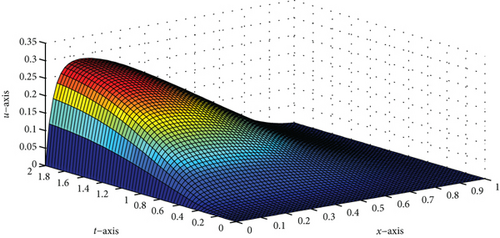
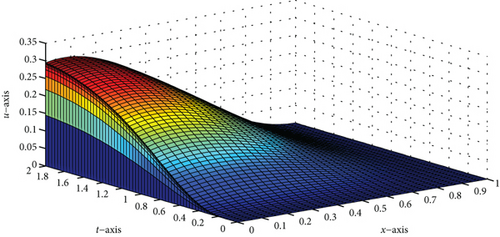
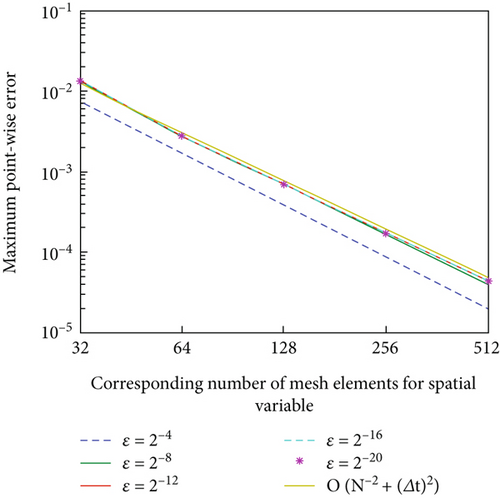
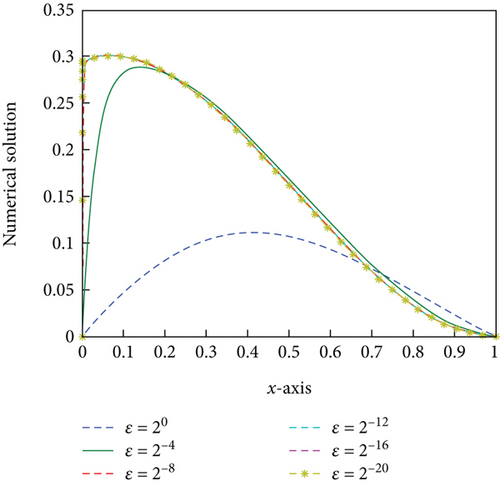
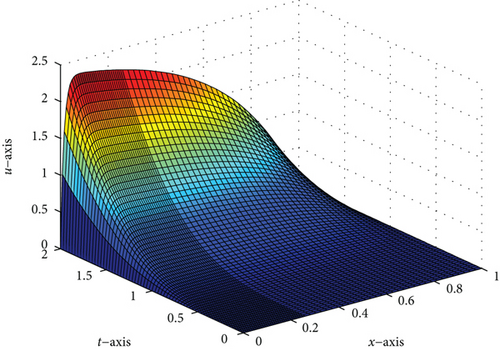
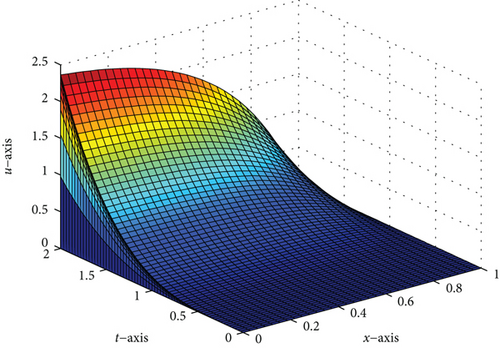
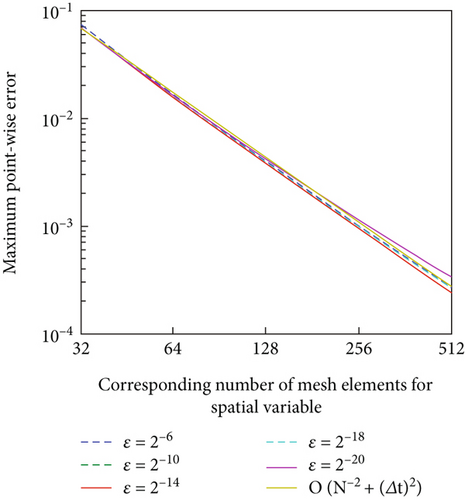
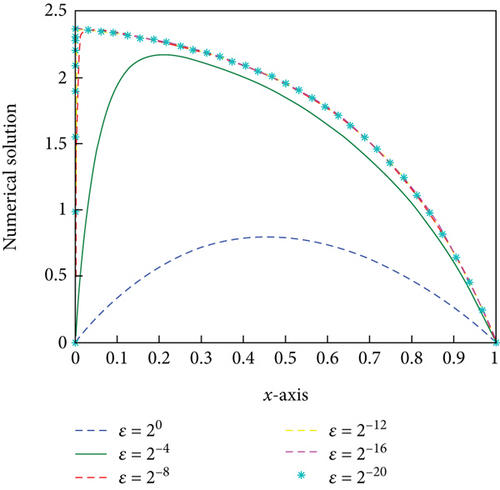
| Method | ε↓ | N→32 | 64 | 128 | 256 | 512 |
|---|---|---|---|---|---|---|
| Present | 2−4 | 7.4172e-03 | 1.6104e-03 | 3.7310e-04 | 8.4234e-05 | 1.9588e-05 |
| 2.2034 | 2.1098 | 2.1471 | 2.1044 | |||
| 2−6 | 1.3309e-02 | 2.7086e-03 | 6.6643e-04 | 1.5562e-04 | 3.4549e-05 | |
| 2.2968 | 2.0230 | 2.0984 | 2.1714 | |||
| 2−8 | 1.3254e-02 | 2.7249e-03 | 6.8167e-04 | 1.6529e-04 | 3.9616e-05 | |
| 2.2822 | 1.9991 | 2.0440 | 2.0609 | |||
| 2−10 | 1.3244e-02 | 2.7338e-03 | 6.8823e-04 | 1.6927e-04 | 4.1768e-05 | |
| 2.2763e | 1.9899 | 2.0236 | 2.0189 | |||
| 2−12 | 1.3241e-02 | 2.7364e-03 | 6.9006e-04 | 1.7037e-04 | 4.2365e-05 | |
| 2.2747 | 1.9875 | 2.0180 | 2.0077 | |||
| 2−14 | 1.3241e-02 | 2.7370e-03 | 6.9055e-04 | 1.7066e-04 | 4.2522e-05 | |
| 2.2743 | 1.9868 | 2.0166 | 2.0048 | |||
| 2−16 | 1.3240e-02 | 2.7373e-03 | 6.9073e-04 | 1.7077e-04 | 4.2578e-05 | |
| 2.2741 | 1.9865 | 2.0161 | 2.0039 | |||
| 2−18 | 1.3240e-02 | 2.7375e-03 | 6.9101e-04 | 1.7092e-04 | 4.2656e-05 | |
| 2.2739 | 1.9861 | 2.0154 | 2.0025 | |||
| 2−20 | 1.3237e-02 | 2.7385e-03 | 6.9201e-04 | 1.7148e-04 | 4.2932e-05 | |
| 2.2731 | 1.9845 | 2.0128 | 1.9979 | |||
| EN,M | 1.3309e-02 | 2.7385e-03 | 6.9201e-04 | 1.7148e-04 | 4.2932e-05 | |
| RN,M | 2.2968 | 1.9845e | 2.0128 | 1.9979 | ||
| [19] | EN,M | 2.9454e-03 | 1.6032e-03 | 8.4467e-04 | 4.3881e-04 | — |
| RN,M | 0.8775 | 0.9245 | 0.9448 | — | ||
| Method | ε↓ | N→32 | 64 | 128 | 256 | 512 |
|---|---|---|---|---|---|---|
| Present | 2−6 | 7.3197e-02 | 1.6164e-02 | 3.9632e-03 | 1.0028e-03 | 2.5984e-04 |
| 2.1790 | 2.0280 | 1.9827 | 1.9483 | |||
| 2−8 | 7.0418e-02 | 1.5592e-02 | 3.8049e-03 | 9.5202e-04 | 2.4123e-04 | |
| 2.1752 | 2.0348 | 1.9988 | 1.9806 | |||
| 2−10 | 6.9688e-02 | 1.5431e-02 | 3.7564e-03 | 9.3481e-04 | 2.3431e-04 | |
| 2.1751 | 2.0384 | 2.0066 | 1.9962 | |||
| 2−12 | 6.9502e-02 | 1.5391e-02 | 3.7448e-03 | 9.3075e-04 | 2.3270e-04 | |
| 2.1750 | 2.0392 | 2.0084 | 1.9999 | |||
| 2−14 | 6.9452e-02 | 1.5387e-02 | 3.7460e-03 | 9.3186e-04 | 2.3336e-04 | |
| 2.1743 | 2.0383 | 2.0072 | 1.9975 | |||
| 2−16 | 6.9425e-02 | 1.5411e-02 | 3.7629e-03 | 9.4068e-04 | 2.3775e-04 | |
| 2.1715 | 2.0340 | 2.0001 | 1.9843 | |||
| 2−18 | 6.9360e-02 | 1.5513e-02 | 3.8335e-03 | 9.7707e-04 | 2.5572e-04 | |
| 2.1606 | 2.0168 | 1.9721 | 1.9339 | |||
| 2−20 | 6.9112e-02 | 1.5927e-02 | 4.1170e-03 | 1.1253e-03 | 3.3204e-04 | |
| 2.1174 | 1.9519 | 1.8712 | 1.7609 | |||
| EN,M | 7.3197e-02 | 1.6164e-02 | 4.1170e-03 | 1.1253e-03 | 3.3204e-04 | |
| RN,M | 2.1790 | 2.0280 | 1.8712 | 1.7609 | ||
| [18] | EN,M | 4.9224e-02 | 2.6666e-02 | 1.3880e-02 | 7.0816e-03 | — |
| RN,M | 0.88436 | 0.94199 | 0.97086 | — | ||
| [19] | EN,M | 2.1953e-02 | 1.1908e-02 | 6.1994e-03 | 3.1627e-03 | — |
| RN,M | 0.88249 | 0.94173 | 0.97097 | — | ||
Conflicts of Interest
The authors declare that they have no conflicts of interest.
Open Research
Data Availability
To support the finding of this study, no data were used.




